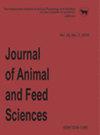乳清粉对苜蓿青贮饲料发酵品质、营养价值和消化率的影响
IF 1.5
4区 农林科学
Q3 AGRICULTURE, DAIRY & ANIMAL SCIENCE
引用次数: 3
摘要
苜蓿(Medicago sativa L.)是一种多年生豆科植物,产量高,富含维生素和矿物质。它可以用作绿色牧草、干草或青贮饲料形式的动物饲料。因为在新鲜苜蓿上放牧会引起鼓膜鼓,这是非常有限的(Jonker和Yu,2016)。尽管干燥的形式通常优选作为动物饲料,但当干燥到12%的适当储存水分时,在该过程中叶片很容易破碎和损失,植物部分的平衡(叶∶茎比)也向纤维素结构转移。这降低了饲料的蛋白质含量、消化率和质量,降低了苜蓿的营养价值,并增加了饲料成本。另一方面,通过使用刺激发酵的添加剂,如水溶性碳水化合物,可以获得成功的青贮饲料(Keener,2019)。乳清是将牛奶转化为奶酪过程中产生的副产品。它的含水量很高(>90%),主要成分是乳糖(占总固体的77%)。乳清粉(WP)是它的干燥形式。它含有高含量的乳糖(69-76%),低含量的水(<7%),富含蛋白质(β-乳球蛋白和α-乳清蛋白)、维生素(B2、B5和C)和矿物质(EWPA,2016)。每年,全球产生的乳清超过2亿吨,而且这个数字每年以约2%的速度增长(Mariotti等人,2020)。摘要。本研究旨在研究乳清粉(WP)对青贮苜蓿(Medicago sativa L.)发酵品质、营养价值和消化率的影响。研究结果表明,与对照组相比,2%和4%可湿性粉剂处理组苜蓿青贮饲料的理化组成和发酵质量有所改善,霉菌生长受到抑制。用2%和4%可湿性粉剂(分别为3.77和1.85 g/kg干物质(DM))处理的青贮饲料中CO2的产生(第7天)远低于对照组(21.36 g/kg DM)。此外,4%可湿性粉剂处理组(76.45%)的体内干物质消化率(DMD)远高于对照组(55.82%)。在该处理组中,粗营养成分和细胞壁组分在体内的所有表观消化率系数都显著增加,因此将净泌乳能量值从1.18 Mcal/kg DM提高到1.31 Mcal/kg。然而,尽管用WP处理的硅烷的体外DMD高于对照,并且剂量显著,但体内和体外值之间没有强相关性。根据我们的研究结果,WP可以为苜蓿青贮饲料的保存提供优势。此外,WP可以被评价为一种可持续的青贮饲料添加剂。接收日期:2021年9月21日修订日期:2021月15日接受日期:2022年2月1日本文章由计算机程序翻译,如有差异,请以英文原文为准。
Effects of whey powder on fermentation quality, nutritive value,
and digestibility of alfalfa silage
Alfalfa (Medicago sativa L.) is a perennial legume with a high yield which is also rich in vitamins and minerals. It can be used as animal feed in the form of green herbage, hay, or silage. Because grazing on fresh alfalfa can cause tympani, it is very limited (Jonker and Yu, 2016). Although the dried form is generally preferred as animal feed, the leaves are easily broken and lost during this process when drying to the appropriate storage moisture of 12%, also the botanical fraction balance (leaf:stem ratio) shifts toward the cellulosic structure. This decreases protein content, digestibility, and quality of the forage, reduces the alfalfa nutritional value, and increases the cost of feed. On the other hand, it could be possible to obtain successful silage by using additives that stimulate fermentation, such as water-soluble carbohydrates (Keener, 2019). Whey is a byproduct resulting from the processes of converting milk into cheese. It has high water content (>90%) and its major constituent is lactose (77% of the total solids). Whey powder (WP) is the dried form of it. It contains high content of lactose (69–76%), low content of water (<7%) and is rich in protein (β-lactoglobulin and α-lactalbumin), vitamins (B2, B5 and C) and minerals (EWPA, 2016). Each year, more than 200 mln t of whey is generated globally, and this value is increasing by ~2% each year (Mariotti et al., 2020). ABSTRACT. The aim of the study was to investigate the effects of whey powder (WP) on the fermentation quality, nutritive value, and digestibility of ensiled alfalfa (Medicago sativa L.). Alfalfa treated with different doses of WP (0, 2, and 4% fresh matter silage) was ensiled in plastic drums for 60 days. The results of the study revealed that the physicochemical composition and fermentation quality of the alfalfa silage improved and that mold growth was inhibited in the groups treated with 2 and 4% WP in comparison to that in the control. Production of CO2 (day 7) was much lower in silages treated with 2 and 4% WP (3.77 and 1.85 g/kg dry matter (DM), respectively) than in the control group (21.36 g/kg DM). In addition, in vivo dry matter digestibility (DMD) was much higher in the group treated with 4% WP (76.45%) than in the control one (55.82%). In this treatment group, all apparent digestibility of coefficients in vivo from crude nutrient contents and cell wall fractions significantly increased and hence raised the net lactation energy value from 1.18 to 1.31 Mcal/kg DM. However, although the in vitro DMD was higher in the silages treated with WP than in the control one and the dose was significant, there was no strong correlation between in vivo and in vitro values. According to our results, WP could provide an advantage for the conservation of alfalfa silage. In addition, WP could be evaluated as a sustainable silage additive. Received: 21 September 2021 Revised: 15 December 2021 Accepted: 1 February 2022
求助全文
通过发布文献求助,成功后即可免费获取论文全文。
去求助
来源期刊

Journal of Animal and Feed Sciences
农林科学-奶制品与动物科学
CiteScore
2.10
自引率
0.00%
发文量
42
审稿时长
3 months
期刊介绍:
Journal of Animal and Feed Sciences (JAFS, J. Anim. Feed Sci.) has been published by the Kielanowski Institute of Animal Physiology and Nutrition, Polish Academy of Sciences in Jabłonna (Poland) since 1991. It is a continuation of the Polish-language journal Roczniki Nauk Rolniczych. Seria B, Zootechniczna published by the Polish Academy of Sciences since 1969.
JAFS is an international scientific journal published quarterly, about 40 papers per year including original papers, short communications and occasionally reviews. All papers are peer-reviewed and related to basic and applied researches in the field of animal breeding and genetics, physiology of nutrition, animal feeding, feed technology and food preservation. The journal distinguishes the multidisciplinary nature of physiological and nutritional sciences and so includes papers specialized in all fields connected with animal well-being, including molecular and cell biology and the emerging area of genetics.
 求助内容:
求助内容: 应助结果提醒方式:
应助结果提醒方式:


